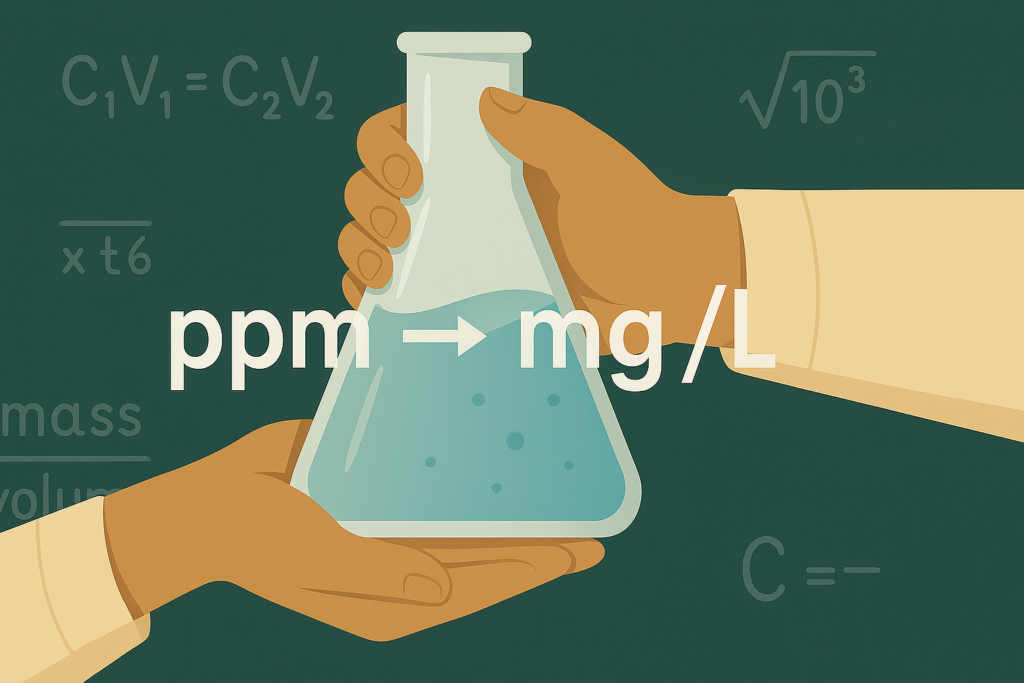Whether you’re working in a laboratory, managing water treatment, or simply reviewing scientific data, you’ve likely come across the terms ppm (parts per million) and mg/L (milligrams per liter). These two units are often used interchangeably, especially in water chemistry. But are they really the same? And how can you convert between them accurately?
In this comprehensive guide, we’ll explain the meanings behind ppm and mg/L, when they are equal, and how to convert them manually or using online tools. We’ll also walk through real-world examples and highlight common mistakes to avoid.
What Do ppm and mg/L Actually Mean?
Before diving into conversions, it’s important to understand what each unit represents:
- ppm (parts per million): This is a dimensionless unit that describes the ratio of one substance in a million parts of another. In the context of water, 1 ppm means 1 part of solute in 1,000,000 parts of solution.
- mg/L (milligrams per liter): This is a mass/volume unit that represents how many milligrams of a substance are present in one liter of solution.
Although the units measure concentration, they do so in slightly different ways: ppm is based on mass ratio, while mg/L is based on mass per volume.

Easily convert Parts Per Million (PPM) to Milligrams per Liter (mg/L), Micrograms per Cubic Meter (µg/m³), and Grams per Liter (g/L) with our free online tool. Fast, accurate, mobile-friendly—get instant results now.
Why a 1:1 Ratio Applies (In Water Context)
In the specific context of dilute aqueous solutions at room temperature, 1 ppm ≈ 1 mg/L. This equivalence holds true because the density of water is approximately 1 kg/L, or 1000 g/L.
Let’s break it down:
- 1 liter of water weighs 1000 grams (or 1,000,000 milligrams).
- So, if you dissolve 1 mg of a substance in 1 liter of water, you’re essentially adding 1 part in 1,000,000 (which is what ppm represents).
Thus, for water and other dilute solutions, 1 ppm = 1 mg/L is a valid approximation.
⚠️ However, this 1:1 rule does not apply to solutions with significantly different densities (e.g., oils, alcohols, or other solvents).
Manual Hand‑Calculation Walkthrough
Let’s go through a simple manual calculation.
Scenario:
You have a water sample with a nitrate concentration of 15 ppm, and you want to know the equivalent in mg/L.
Step-by-step:
- Assume 1 ppm ≈ 1 mg/L (because the solvent is water).
- Result: 15 ppm = 15 mg/L.
Pretty simple in this case. Now let’s try a reverse calculation:
Scenario:
You measured 25 mg of calcium in 1 liter of water. What is this in ppm?
Step-by-step:
- You have 25 mg / 1 L = 25 mg/L
- Using the 1:1 rule, 25 mg/L = 25 ppm
This method works flawlessly in most water-based laboratory settings.
Using Online Tools and Calculators
For those who want accuracy without the math, online converters and calculators come in handy. Some of the best tools include:
- smart unit calculator
- CalculatorSoup
- Aqua-Calc
How to Use Them:
- Open the tool and select the conversion type (ppm to mg/L or vice versa).
- Enter your known value.
- Select the substance if the tool supports it (some let you adjust for density).
- Click convert to get the result instantly.
These tools are especially useful when:
- You’re dealing with non-water solutions.
- You need temperature or density adjustments.
- You’re handling large datasets or lab results.
Real‑World Application Examples
1. Drinking Water Quality
Water testing reports often list contaminants like lead, nitrates, or chlorine in ppm or mg/L. For example:
- EPA allows a maximum of 10 mg/L of nitrate, which is 10 ppm.
2. Aquarium Maintenance
Fish tanks require constant monitoring of pH and ammonia, often listed in ppm. If ammonia levels are at 0.5 ppm, it equals 0.5 mg/L—a critical value for fish health.
3. Agriculture and Fertilizers
Soil and water nutrient levels are commonly measured in ppm. Knowing that 1 ppm equals 1 mg/L helps farmers adjust irrigation systems more precisely.
Tips and Common Mistakes
✅ Tips:
- Always confirm the density of the solution when working with solvents other than water.
- Use online tools when dealing with complex matrices or temperature-sensitive solutions.
- For quick lab estimations, use the 1:1 ppm = mg/L rule for aqueous solutions.
❌ Common Mistakes:
- Assuming the 1:1 ratio applies to all substances—this can lead to major errors with oils or alcohols.
- Ignoring units—some calculators require you to input values in specific units (e.g., mg, g, L).
- Rounding errors—especially when dealing with small concentrations or highly sensitive measurements.
Conclusion
Converting ppm to mg/L is surprisingly straightforward in most cases, especially in water-based environments. The key is to understand the context—whether the solution is dilute and aqueous. In these scenarios, 1 ppm equals 1 mg/L, making it easy to switch between the two.
For more accurate or non-aqueous conversions, tools and calculators can simplify your task and reduce error. Whether you’re a scientist, student, or someone working in agriculture or water treatment, mastering this basic conversion can save time and improve accuracy in your work.

